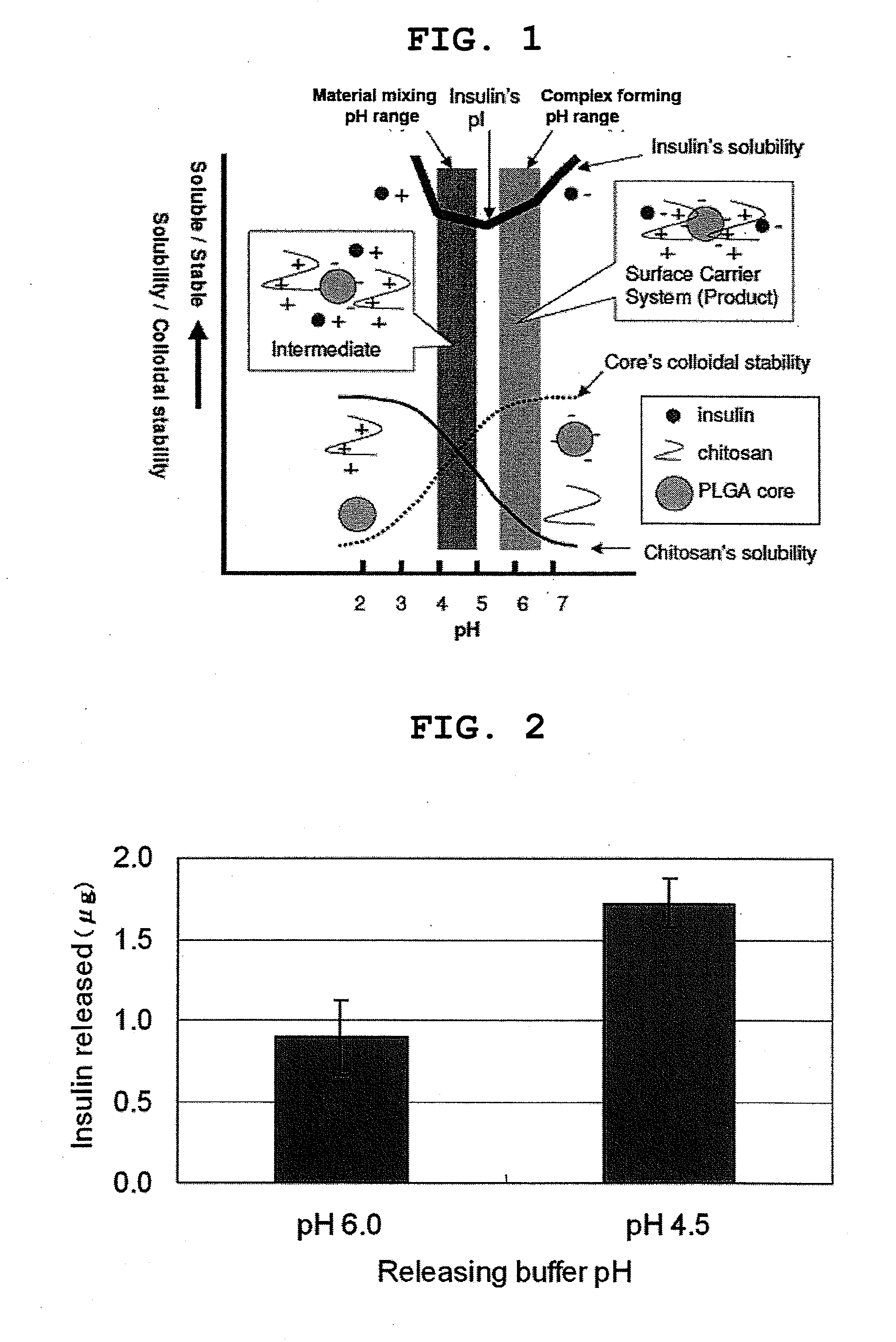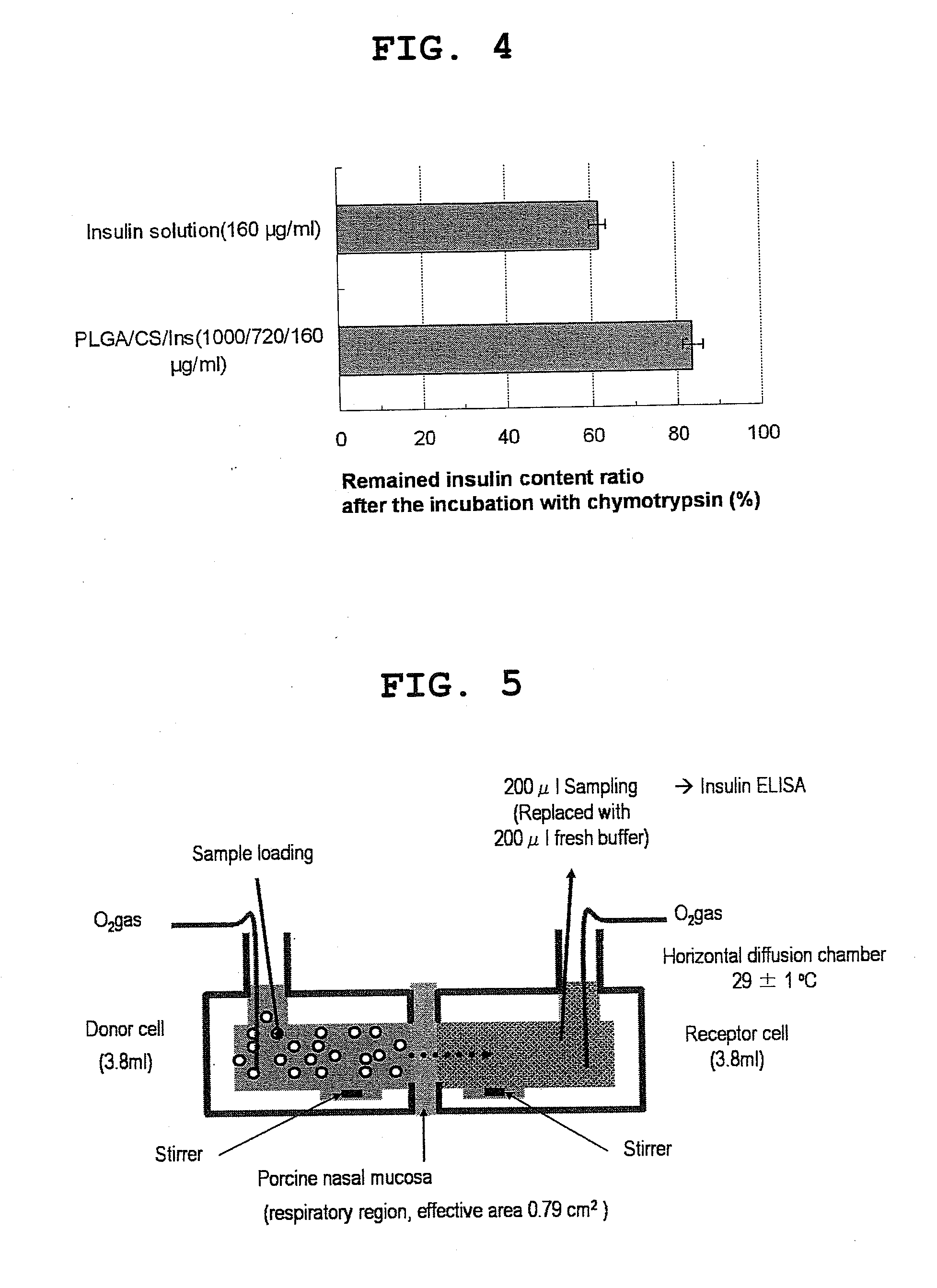Pharmaceutical composition containing surface-coated microparticles
a technology of surface coating and pharmaceutical composition, which is applied in the direction of powder delivery, dna/rna fragmentation, and macromolecular non-active ingredients, etc., can solve the problems of difficult administration of compound into the body, drug is not easily absorbed, and the younger patient does not necessarily follow the dosing regime of compound administration
- Summary
- Abstract
- Description
- Claims
- Application Information
AI Technical Summary
Benefits of technology
Problems solved by technology
Method used
Image
Examples
preparation example 1
Preparation of poly(lactic-co-glycolic acid) (PLGA) Small Particles of Various Particle Sizes
PLGA small particles were produced using a PLGA with a lactide:glycolide ratio of 50:50 (RESOMER RG 502H, Bohringer Ingelheim). The PLGA was dissolved in HPLC grade acetone at the required concentration. The PLGA / acetone solution was added dropwise to purified water in a ratio of 1:3 under constant stirring. The mixture was stirred until the acetone had fully evaporated (approximately 4 hours).
The particle size distribution of resultant small particles was measured by a dynamic light scattering measuring apparatus (DLS 802, Viscotek). Table 1 shows the relationship between the PLGA concentration and the diameter of obtained particle. It is evident that by reducing the polymer concentration in the initial organic solvent solution, smaller particles can be easily and reproducibly obtained.
TABLE 1Effect of PLGA concentration on particle sizeLGAPLGA smallconcentration inparticle diameter (nm)ace...
example 1
Preparation of Small Particle System Surface-Coated with Drug-Surface-Coating Polymer Complex in Two Different Buffer Systems
Insulin (pI about 5.3) was used as a protein drug, and chitosan was used as a positively charged surface-coating polymer.
1.5 ml of bovine insulin (Sigma, 160 μg / ml) in 0.5 mM citric acid solution (pH 4.5) was added to 1.5 ml of chitosan (Bioneer 143 kDa, 0.72 mg / ml) in 0.5 mM citric acid solution (pH 4.5) and the mixture was left at room temperature for at least 30 min. Three ml of PLGA small particles (about 100 nm in diameter; hereinafter, also to be referred as “PLGA 100”) suspension in 0.5 mM citric acid solution (pH 4.5; concentration of PLGA small particle: 500 μg / ml) prepared as described in Preparation Example 1 was added to the chitosan / insulin solution and the mixture was left at room temperature for at least 1 hour. The pH was increased to 6.0 with NaOH (0.1-2.5N), and salts and supplements were added thereto to afford the same solvent compositions ...
example 2
Preparation of a Small Particle System Surface-Coated with Drug-Surface-Coating Polymer Complex in a 20 mM MES Buffer System with Two Different Concentration of Insulin
Insulin (pI about 5.3) was used as a protein drug, and chitosan was used as a positively charged surface-coating polymer.
Two ml of bovine insulin (Sigma, 160 μg / ml or 800 μg / ml) in 0.5 mM citric acid solution (pH 4.5) was added to 2 ml of chitosan (Bioneer 143 kDa, 0.72 mg / ml or 3.6 mg / ml) in 0.5 mM citric acid solution (pH 4.5) and the mixture was left at room temperature for at least about 30 min. Four ml of PLGA small particles (about 100 nm in diameter) suspension in 0.5 mM citric acid solution (pH 4.5; concentration of PLGA small particle: 0.5 mg / ml or 2.5 mg / ml) prepared as described in Preparation Example 1 was added to the chitosan / insulin solution and the mixture was left at room temperature for at least 1 hour. The pH was increased to 6.0 by adding NaOH (0.1-2.5N), and salts and supplements were added theret...
PUM
| Property | Measurement | Unit |
|---|---|---|
| particle size | aaaaa | aaaaa |
| particle size | aaaaa | aaaaa |
| mean particle size | aaaaa | aaaaa |
Abstract
Description
Claims
Application Information
 Login to View More
Login to View More - R&D
- Intellectual Property
- Life Sciences
- Materials
- Tech Scout
- Unparalleled Data Quality
- Higher Quality Content
- 60% Fewer Hallucinations
Browse by: Latest US Patents, China's latest patents, Technical Efficacy Thesaurus, Application Domain, Technology Topic, Popular Technical Reports.
© 2025 PatSnap. All rights reserved.Legal|Privacy policy|Modern Slavery Act Transparency Statement|Sitemap|About US| Contact US: help@patsnap.com



